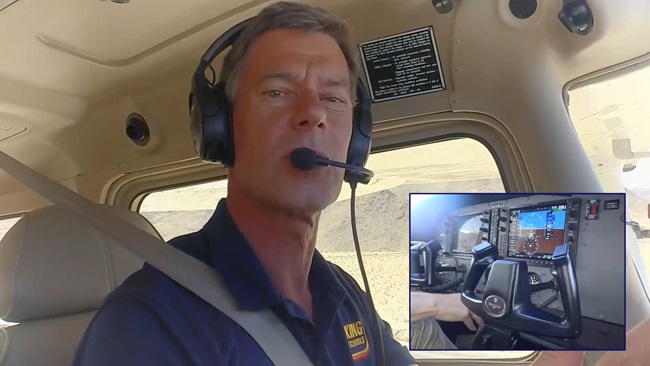
Illustration by Daniel Hertzberg
Single-pilot flying is one of the greatest joys a pilot can experience. Flying an aircraft solo, in IMC to boot, is thrilling, emotionally gratifying, mentally challenging, and just downright fun. However, with greater rewards come greater risks, so preparing for the unknown becomes that much more important. I want to share methods I have found to be helpful over the years along my journey as a professional pilot.
Time. We’re always trying to understand it, gain it, save it, rewind it, and spend it. As single pilots, we always need more of it, and where this becomes most apparent is with abnormal situations. Whether you’ve just had a reroute, a PFD or MFD screen failure, an engine failure, or numerous other escalating abnormalities, buying yourself time will improve your outcome significantly. Why? As humans we can only do so much at one time, and as our minds become overloaded, our attention to detail, methodical thinking, and general common sense tend to go out the window.
If you can slow things down and increase your time to mentally take charge, the outcome of a challenging situation will improve. An extreme example of this is when I first experienced the infamous V1 cut (simulated engine failure at the calculated V1 speed) in the Saab 340. The 340 is a fantastic aircraft, but with two powerful engines and conventional props, losing an engine at a critical time can make for a bad day. No doubt about it, the first time I experienced a V1 cut in the simulator, I encountered situational overload. The alarms and lights were screaming and the airplane’s rolling tendencies immediately became extreme as I watched the heading bug move from front and center to slipping side to side.
It didn’t take a long debrief to figure out the reason for the chaos: I jumped to action without buying an extra second or two of time. This, of course, caused even more of an upset. FAR Part 25 certification rules require the aircraft to meet specific climb performance with an inoperative engine, and V1 cuts take into account a twosecond human brain delay. Clearly I had to change my ways.
I mention this extreme case because even at the worst of times, there’s time. There’s time to gain composure and make a decision. In the case of an engine failure at V1, the decision is supposed to have already been made for you: you’re going. Be that as it may, once I learned to slow myself down (“buy time”), take fast but accurate and deliberate action, and understand the consequence of rushing, a terrible situation could become orderly, timely, and successful. A wise simulator instructor once told me, “When the crap hits the fan, look down at your watch and pretend to wind it three times.” Of course you won’t actually do this, but you understand the point: take a vector, or use the FMS to hold on a published holding fix, for example. Anything to avoid jumping at the situation.
Thoroughness and preparedness.This is always important, but vital to the single pilot. Systems knowledge, checklist understanding, memory items, and procedures all are necessities that need to be thoroughly understood. If you’re in need of brushing up on emergency procedures, you’re not 100 percent prepared for single-pilot missions.
For example, while flying a typical winter leg a couple of months ago, a deice boot failure occurred while climbing out of Greater Rochester Airport in New York on an icy, low-overcast, low-visibility day. Looking out the pilot side window, I noticed the outboard boots were stuck in the inflated position. The inboards were flush, the tail boots were an unknown, and there was no caution message other than a quick chime and flash of the master caution; it disappeared as fast as it came.
Luckily, I had just punched through the top layer at FL190. Immediately, however, I knew this was only the start of the issue. Our destination weather at Waterbury-Oxford Airport in Connecticut was to minimums and daylight would soon disappear. I had to prioritize. The destination and descent were soon to commence, but clearly this was not an immediate option. I bought time and requested a hold from ATC. This allowed me to slow my actions before allowing the chain to develop, and to prioritize a plan of action.
I pulled out the QRH—Quick Reference Handbook—for “deice boots” (because I did receive a momentary caution), and found limited guidance. Nevertheless, I knew I had plenty of fuel to outfly the cloud cover, and I had recently reviewed icing incidents, aerodynamics, and procedures. Long story short, it was thoroughness and preparedness, along with time, that turned what could have been an interesting situation into a manageable issue.
Single pilot resource management (SRM). We’ve all read about it. We’ve all had experience with it—or least with its cousin, crew resource management (CRM). However, SRM is vital to pulling yourself out of a sticky situation, whether it’s using your passengers (with or without aviation experience), ATC, or onboard systems.
I used SRM by asking ATC to query other pilots in the area about temperatures at different altitudes. I had a passenger read a checklist and help look outside the airplane, and lastly I referred back to the flight manual for system guidance when all the checklists led to a dead end. All of these available resources helped secure a safe outcome. And though many feel insecure about declaring an emergency, this also can be a useful tool for a single pilot facing certain situations. When you’re the only one to aviate, navigate, and communicate, you absolutely will need assistance in some way to help you out.
Proficiency versus currency. We understand the regulations associated with FAR parts 61.56 and 61.57, and the definitions for each are very different. On every flight I take, like many pilots, I constantly run through scenarios of all sorts—What if my engine fails here? How about an engine fire, loss of pressurization, ILS goes down, a portion of the panel is lost, or visibility drops below minimums inside the final approach fix? The list goes on and on. Consistently drill yourself, and learn the aircraft and also feel more confident. Just don’t get over-confident.
Sure, the thought of an emergency while flying single pilot is daunting—and it can be just that. However, if you take the above steps, I can almost guarantee an increased chance of a safe outcome. The Pilatus PC–12NG I fly makes it very easy to handle many situations, although the same systems that can make it easy also can be your worst enemy. But no matter what you fly, remember that you’re doing the work of two, so when things quickly start going down the drain, look down and pretend to wind your watch three times.
Todd Hotes is the chief pilot of an FAR Part 91 flight department and former check airman.


